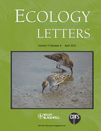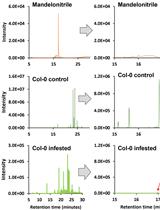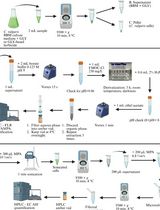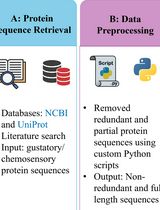- EN - English
- CN - 中文
An Inexpensive and Comprehensive Method to Examine and Quantify Field Insect Community Influenced by Host Plant Olfactory Cues
一种分析量化寄主植物嗅觉引诱性物质对田间昆虫群落影响的低成本、综合方法
发布: 2018年08月20日第8卷第16期 DOI: 10.21769/BioProtoc.2967 浏览次数: 6407
评审: Anonymous reviewer(s)
Abstract
Insect pollinators, herbivores and their natural enemies use olfactory cues emitted by their host plants to locate them. In insect-plant ecology, understanding the mechanisms underlying these interactions are of critical importance, as this bio-communication has both ecological and agricultural applications. However, the first step in such research is to identify and quantify the insect community associated with the plant/s species of interest. Traditionally, this has been accomplished by a variety of insect trapping methods, either using pitfall traps, or sticky traps, or sweep nets in field. The data collected from these traps tend to be incomplete, and also damage the specimens, making them unusable for any taxonomic purposes. This protocol derives ideas from these traditional traps and use a combination of three easily made inexpensive modified traps that conceals the host plant, but allows the plant volatiles to pass through as olfactory cues. These traps are economical, can be made to fit with most plant sizes, and are also reusable. Collectively, these traps will provide a solid estimate (quantifiable) of all associated community of arthropods that can also be stored for future studies.
Keywords: Herbivores (食草动物)Background
To defend against the wide range of herbivorous insects that feed on them, plants have evolved a wide range of defenses that include direct and indirect defenses (Howe and Jander, 2008; Kariyat et al., 2012 and 2013). Among these, plant volatiles are a major group that falls under indirect defenses. Plant volatiles are low molecular weight high vapor pressure organic secondary metabolites emitted by plants as part of their normal metabolic activities (Pare and Tumlinson, 1999). However, when herbivores feed on them, they alter their volatile emission by varying it both qualitatively (number of compounds emitted) and quantitatively (amount and ratio of each compound in the blend) (Pare and Tumlinson, 1999; Kariyat et al., 2012). This altered volatile bouquet is also known as herbivore-induced plant volatiles (HIPV). HIPV are the major olfactory cues that the natural enemies (predators and parasitoids) of these herbivores use as signals to find their host–the herbivores (Kariyat et al., 2012), thereby indirectly improving host plant fitness. In addition, undamaged plants also emit volatile organic compounds that are used as cues by herbivores to locate their host plant for both feeding and oviposition (Kariyat et al., 2013 and 2014). A critical component of such insect-plant interaction studies involving plant volatiles is to examine and quantify the community of insects (herbivores, predators, pollinators, and other natural enemies) that gets attracted to their hosts under field conditions (Kariyat et al., 2012). Traditionally, such studies have employed one or a combination of insect traps such as commercial sticky traps, pheromone traps, and light traps to name a few. However, most of these traps have visual aid that interferes with olfactory cues. This can affect understanding the role of olfactory cues, and in many cases, the traps only collect only a subset of the actual insect community associated with the host.
This protocol provides detailed instructions to use inexpensive and easily available materials to build a combination of three traps-which when combined will carry out comprehensive trapping of the majority of insects associated with the hosts (Kariyat et al., 2012). These traps can easily be assembled and disassembled, and are also reusable. The basic methodology involves building a cage from hardwire cloth which encloses the host plant/s of interest, two pitfall traps made of plastic cups, and a pan trap made of aluminum that fits on top of the cage. Combined, these traps will collect insects flying above and at the canopy level, and insects that either crawl or are soil dwellers.
Materials and Reagents
- Hardwire cloth, 0.635 cm mesh size, 0.61 x 3.05 m (Lowe’s, Blue Hawk, catalog number: 492388 , model: 840147)
- Zip ties, 28 cm, White,100 Ct (Lowe’s, UtilitechTM, catalog number: 76025 , model: SGY-CT18)
- Aluminum pie pans, 22.2 cm dia. x 2.9 cm (Handi-Foil, catalog number: 20305E-3 )
- Plastic cups, 9 oz, Clear (Solo, Walmart, 554949033)
- Woodenskewers/dowels, 4.76 mm dia., length 30.5 cm (Walmart, 554544726)
- White Bridal veil fabric, 0.22 m x 0.18 m, mesh size: 1 mm2 (Hobby Lobby, catalog number: 852640 )
- A4 size white paper (Staples, catalog number: 135855 , model: 135855 / 135855 WH)
- A4 size acetate sheets (Staples, catalog number: APOCG7031S , model: CG7031S)
- Glass vials 40.7ml (Fisher Scientific, catalog number: 03-338L )
- Distilled water
- Odorless tangle foot sticky glue (Tangle-Trap® Sticky Coating) (TANGLEFOOT, catalog number: 300000676 , Part No. LB8249)
- Micro 90 odorless detergent (Micro-90) (Cole-Parmer, catalog number: SK-18100-05 )
- 80% ethanol (Sigma-Aldrich, catalog number: 793191-4X1GA-PB )
Equipment
- Scissors
- Hardwire cloth wire cutter, Fatmax 5.08 cm 60 CrV snips (Stanley Black & Decker, catalog number: FMHT73563 )
- 4 °C refrigerator
- Microscope
Software
- Minitab v. 14
Procedure
文章信息
版权信息
© 2018 The Authors; exclusive licensee Bio-protocol LLC.
如何引用
Kariyat, R., Chavana, J. and Kaur, J. (2018). An Inexpensive and Comprehensive Method to Examine and Quantify Field Insect Community Influenced by Host Plant Olfactory Cues. Bio-protocol 8(16): e2967. DOI: 10.21769/BioProtoc.2967.
分类
植物科学 > 植物生物化学 > 其它化合物
环境生物学 > 植物 > 植物-昆虫互作
您对这篇实验方法有问题吗?
在此处发布您的问题,我们将邀请本文作者来回答。同时,我们会将您的问题发布到Bio-protocol Exchange,以便寻求社区成员的帮助。
Share
Bluesky
X
Copy link













